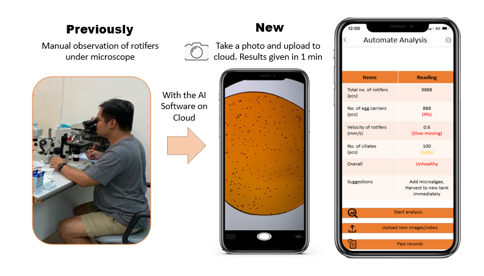USE OF ARTIFICIAL INTELLIGENCE (AI) TO AUTOMATE ROTIFER COUNTING AND OBSERVE ROTIFER POPULATION
Rotifers, a type of zooplankton, are critical first feed for young marine fish larvae. A successful intensive marine fish fry production in a hatchery therefore depends heavily on a stable in-house rotifer cultivation. A lack of rotifer supply due to culture instability can result in mass mortalities of fish fry due to lack of food, and sharp reduction in hatchery production. However, ensuring rotifer culture stability is both time consuming and labour-intensive. At SFA’s Marine Aquaculture Centre, staff spend at least 40 minutes daily using a microscope to count both live and dead rotifers, note rotifer movement speed, and presence of contaminants such as ciliates. Staff then analyse these observations and make decisions to implement operational actions to maintain and improve stability of rotifer cultures. The rotifer counting and assessment of culture quality require well-trained staffs, with the experience to make the right calls when the rotifer culture is unhealthy. This topic describes a prototype using Artificial Intelligence (AI) to automatically count rotifer and assess rotifer population for greater operational efficiency. With this method, end users simply use their smartphones to capture images of rotifers and upload it to a cloud whereby the online software will analyse and provide parameters and suggest operational actions to maintain the stability of rotifer cultures. Potential adoption by farms and Institutes of Higher Learning (IHLs) both locally and word widely could also result in increased industry productivity.
